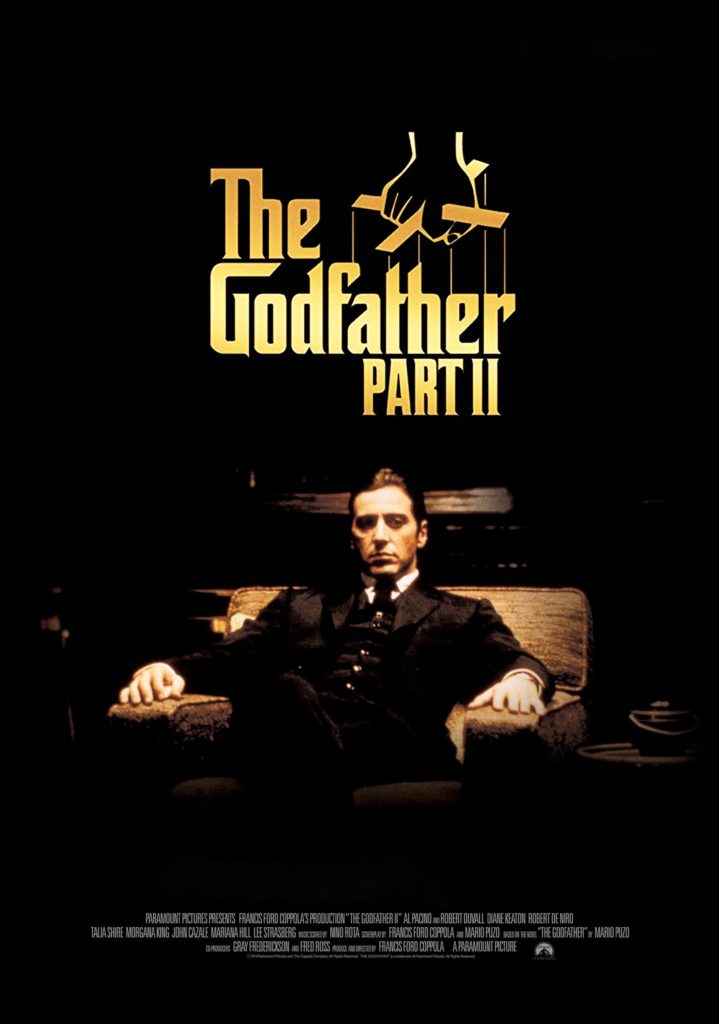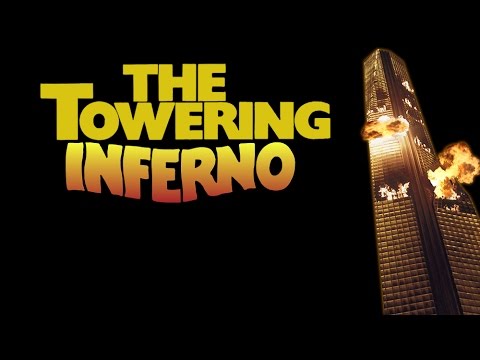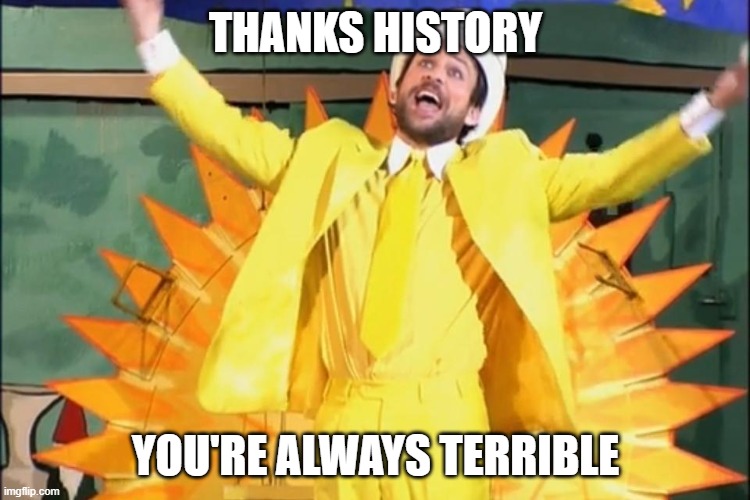1974
A juggernaut returns, but the early 70s’ biggest hit parade hits its zenith. Hits are getting bigger, and despite the Academy’s attempts to be “hip” and “with it,” they’re not keeping up… even with what seemed like a sure thing for joint champion.
And The Oscar Goes To…
Round two, babycakes
This one’s a half hour longer than the last, but it’s a better value, as it’s a sequel and a prequel in one movie. The main event, the real Godfather Part II, is Michael, two years after we last saw him, and how his attempts to legitimize the family business go off the rails, and he may not be able to hold onto both his family and The Family. Intercut into Michael’s story is Godfather Origins, in which we follow young Vito from fleeing the Sicilian mobster who killed his family and doesn’t want any kids growing up to seek vengeance* to growing into Robert De Niro and starting the Corleone crime empire through taking out the local extortion king.
*Works about as well as killing all the newborn Hebrew children so none of them would grow up and free the Hebrew slaves, it’s like nobody in a movie ever heard the Appointment in Samarra story, all sowing their own destruction.
De Niro does a great job at playing a younger version of Brando’s Vito, capturing his vocal mannerisms even while doing nearly all his dialogue in Italian. Pacino is even better as Michael than last time, and there’s some meaty work for Fredo that John Cazale just slays. The timeline is much tighter for the Michael story than the first movie, which covered ten years, but most of those years happened in the last forty-five minutes, leading to those dizzying time jumps I mentioned. Cutting back and forth from Vito to Michael makes the time jumps in Vito’s arc easy to follow, because every time we cut back to Vito, you can assume it’s been a minute since we last checked in on him.
What’s also interesting is that it ends with a similar “take care of all family business” montage to part one, but the atmosphere becomes much grimmer… not because it’s more violent, but because the element of triumph from the last one is gone. This isn’t Michael ascending, this is Michael falling as low as he’s ever been.
I guess my one main note is that some of the tension is gone, as in place of a proper gang war, it’s Michael trying to find out who betrayed him and what’s to be done about it. Still works, slightly less gripping.
And Rotten Tomatoes Says: Just out of the top ten at #12, under Rebecca, over On The Waterfront. Still a high watermark for a sequel, just slightly less masterful.
What’s New, Hollywood? The idea of a sequel continuing the story instead of just trying to hit the same plot beats is a little radical now, sadly. If you’d like a more detailed look at Francis Ford Coppola’s filmography and impact on film, Patrick Willems did it better than I could. Yes, two links, two videos, there was a lot for him to cover.
The Box Office Champ
Okay. Let’s talk 70s disaster movies.
The 70s liked disasters almost as much as the 50s liked bible epics or the 2010s loved superheroes. Some theorize that a spike in global unrest, including hijackings, bombings, and other terrorist incidents caused a general mood that was favourable to movies about brave people attempting to survive horrible situations. That disaster movies made a mild comeback after 9/11 would back that. Airport was the pioneer in 1970; The Poseidon Adventure kept the party going in 1972, and is thought to be one of the better ones; and by 1974, there were three disaster movies in the year’s top ten grossers: Airport 1975 (natch), Earthquake, and our champion, The Towering Inferno. Aka “The One Without Charlton Heston.” Which I am fine with.
Anyway, The Towering Inferno has all the hallmarks of a 70s disaster flick: a cast full of big names (including Faye Dunaway, Sunset Boulevard’s William Holden, Robert Wagner, and Fred Astaire of all people), a desperate attempt to survive a cataclysm, and producer Irwin Allen, who rode this genre until it died on him and he ran out the clock of his career in television. It’s the grand opening for San Francisco’s new tallest skyscraper, and high society is celebrating it way up on the 110th floor… but the owner’s son-in-law (a weaselly Richard Chamberlain, the film’s only villain) cut corners on wiring, and short circuits both start a fire on the 81st floor and cripple the building’s ability to detect or respond to it. By the time the fire is discovered, it’s already spreading, until the building becomes the thing from the title.
You have noble characters trying to save as many people as possible (primarily Paul Newman as the building’s architect, who was on vacation when the contractors were cutting corners, and Steve McQueen as the fire chief running the response). You have civilians caught above the blaze, desperate to escape, only some of which manage it. Meaning yes, there are deaths, sometimes of people you like, sometimes of people they’ve worked almost too hard to attach you to, once of that asshole who isn’t sorry about the shoddy wiring he installed.
What you don’t have is the rigid structure of 2000s disaster movies that I noticed in things like Poseidon (the remake), The Core, or the Doctor Who episode “Voyage of the Damned,” where the cast have an Objective (often but not always “safety”), and between them and the Objective are a series of set-piece obstacles, every time they clear an obstacle someone dies, and the closer to the end you are, the more likely said death is to be a willing sacrifice. And I’m not making that up as a formula, I know this because if I were, then why did Rick and Morty parody it so precisely with “Anatomy Park?” But that’s not how The Towering Inferno works, and I imagine not how the Airport series worked either. There’s just a disastrous situation, and the longer it’s happening the worse the situation becomes, and the more people it can kill.
I enjoy how earnestly Paul Newman and Steve McQueen play everything. They are the highlights of the cast. Lowlights include Newman’s son as “Young Firefighter” (don’t Google him, it’s sad) and future murderer OJ Simpson. Ugh. Avoided child-rapist Roman Polanski only to run head-first into knife-murderer OJ Simpson.
I also enjoyed how eventually characters got blasé about small amounts of fire being everywhere. Early in the process, any amount of fire is a risk, late in the movie Newman’s just strolling past small to medium patches of fire like minor inconveniences. It doesn’t diminish the threat, because parts of the building are still exploding and that’s making it harder and harder to get people down 110 stories to the ground, but it’s mildly amusing.
Yeah there’s some badly aged green screen work, but what choice did they have? Digital effects didn’t exist yet and not even modern-day James Cameron gets to build an actual 110-story skyscraper so he can set it on fire. And sure in the opening and closing, it’s a bit over-the-top in its loving tribute to firefighters. Makes Michael Bay’s cinematic love-letters to the military seem almost subtle in comparison.
But I don’t know, I guess I see what the appeal was. There’s real suspense and some jaw-drop deaths. It has a score from John Williams, that always helps. I knew we’d be talking John Williams scores this decade, but not so fast. Could have been shorter, given the amount of time they spent establishing future fire victims that, by the end, I couldn’t describe in even the broadest detail. (For instance an… executive? Of some sort? He and his secretary/mistress are two of the earliest fire deaths and I don’t think anyone else in the cast actually noticed.)
(Small fact… this is the first movie in the project I’ve seen use a now-common visual trick to give two leads roughly equal billing: Paul Newman and Steve McQueen’s names share a title card, but one is to the left and the other is higher up, giving each their own form of prominence.)
And Rotten Tomatoes Says: It rated a 69% with critics and a 72% with audiences, I guess I was right, they should have scraped off 45 minutes. Of course cut too much and you get the Poseidon remake. It was 90 minutes but felt twice as long.
What’s New, Hollywood? This was new when it was Airport. This may have been the genre’s apex, but it’s also its halfway point. Yeah, I haven’t been saying “70s disaster movies” for no reason, Hollywood just moved on come 1980. Not that disaster movies ever completely went away, no genre ever truly dies, they just needed to take a breather and come back with a little more oomph, like asteroids or alien invasions or geostorms or needing to drill to the centre of the Earth to reboot the planet’s magnetic field. Like you do.
Other Events in Film
- This Year in Bond: Roger Moore’s James Bond faces off with Christopher Lee as The Man With the Golden Gun.
- At number two at the box office? Blazing Saddles from Mel Brooks. Under that? Young Frankenstein. Has anyone had as good a filmmaking year as Mel Brooks in 1974? Yes and we will get to it.
- One year after The Exorcist brought new acclaim to the horror genre, the slasher fic begins to break out with Canadian-made Black Christmas. Oh and this other thing called The Texas Chainsaw Massacre, you might have heard of that one.
- An all-star cast assembles for Murder on the Orient Express, proving it’s not just Kenneth Branagh who can manage that.
- Chinatown comes out to worldwide acclaim, and is generally considered a masterpiece, but audiences and the Oscars gave it a pass so I don’t need to unpack what a piece of garbage Roman Polanski turned out to be. The Globes would have made me go there, they loved Chinatown.
- Al Pacino and Jack Nicholson both lost Best Actor to Art Carney for Harry and Tonto, firmly setting a precedent of the Oscars handing actor trophies to people they assume are “due” rather than the best performance. This certainly is a perfect case study.
- John Carpenter’s first movie, Dark Star, opens.
- Violent revenge flicks find their big icon in Death Wish with Charles Bronson.
- Lawsuits settled and SAG rulings made, The Four Musketeers comes out.
- They made a sequel to Fritz the Cat but without Ralph Bakshi? Odd choice.
- Brian De Palma makes a bizarre adaptation of Phantom of the Opera (and some other things) called Phantom of the Paradise, which tanks initially but becomes a cult classic.
- Steven Spielberg and a young Goldie Hawn do the crime flick The Sugarland Express. He gets John Williams to write the music. Not to spoil anything but this partnership worked out kinda well.
- Sean Connery gives us all the evidence we’d ever need that he did not read scripts before signing on to a movie by starring in Zardoz.
- Truck Turner isn’t the most famous blaxploitation movie but damn my friends and I had some fun with it back in the olden times of the late 90s, early 00s. Simpler days.
- The flaw with this project’s structure is that I’m talking Towering Inferno when Sonny Chiba managed to crank out four, four different Street Fighter movies this year, FOUR. The Street Fighter, Return of the Street Fighter, The Street Fighter’s Last Revenge, and Sister Street Fighter all claim 1974 as their release date (as does Sister Street Fighter: Hanging By a Thread, but Chiba’s not in that one). As the Scottish would say, I dinnae Ken how this happened, I’m drawing a Blanka over how they had the Guile to stampede theatres with Street Fighters like a herd of Bison, they dug so deep into the kung fu craze we’re lucky they didn’t unleash a Balrog.
I’m not sorry.
So the Oscars are trying, they are trying to go with crowd-pleasers, but they still want some amount of substance, whereas audiences are being drawn to bigger and bigger spectacles even at the expense of theme or story. Thing is… sometimes it didn’t take a burning skyscraper to get spectacle. A true master can thrill record crowds with nothing but barrels floating on the surface of the ocean. In the words of the poet… Don’t believe me? Just watch.
Next Page: Duhhhhh dun. Duhhhhh dun. Duhhhh dun-dun-dun-dun…



